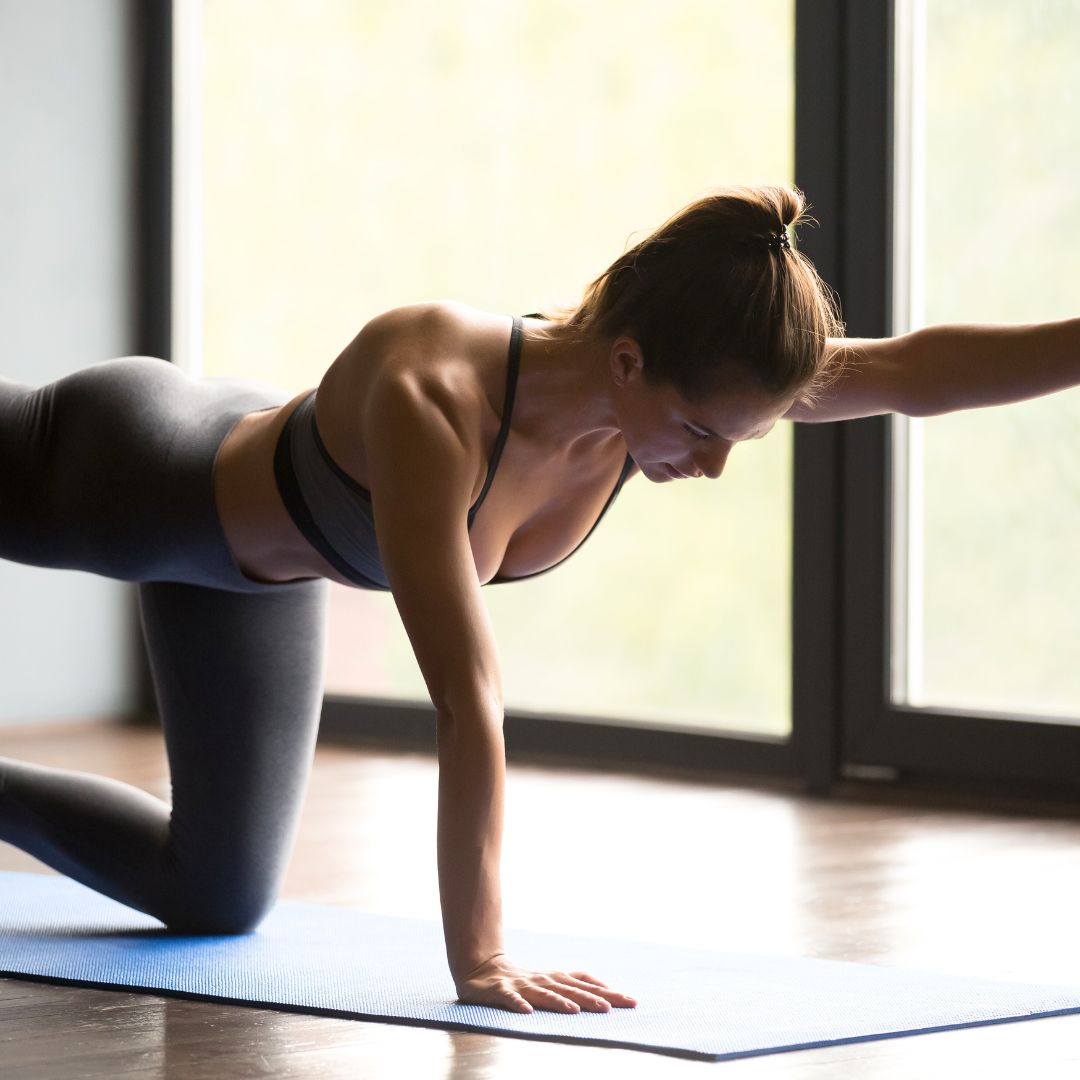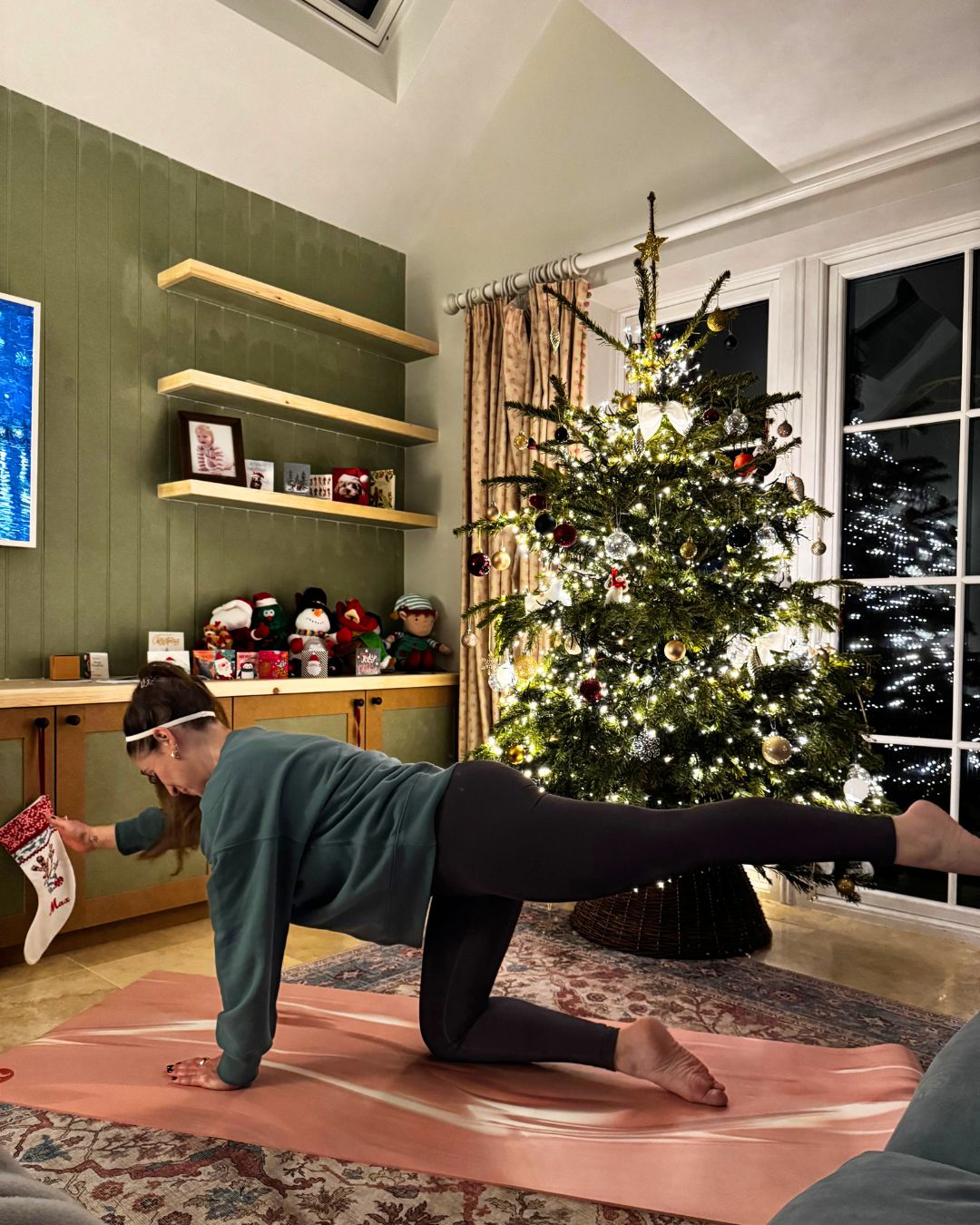
As a Health Writer, I've done my fair share of core exercises. Be it crunches, planks, dead bugs, or standing core moves, you name it, I've tried it. So, when I was asked to try doing bird dogs every day for two weeks, it was a no-brainer. I mean, how hard could they be?
At first glance, the bird dog might not seem the most effective core move, but experts are hailing it as one of the best ways to strengthen and stabilise your abdominals, so I was keen to discover what I'd been missing. The science stacks up, too, with research showing that the move is not only good for core activation, but works to strengthen the whole body, too.
"Bird dogs strengthen the deep core muscles and stabilise the spine, making them an excellent choice for improving posture and preventing lower back pain," explains Pilates instructor Aleksandra Warburton. "They’re also great for developing balance and coordination."
After having three children, I know that my core and back strength is a fraction of what it once was (thanks, kids!) so I'm keen to find out if a fortnight of targeted moves will make a difference, but I'm also intrigued to know whether they'll ease some of my niggly mid-back pain that flares from time to time. As for my balance, I've been working on that religiously for a year or so now - so I'm hoping that'll be a walk in the park.
Keep scrolling for my verdict - plus, the hurdles I came up against (just keeping it real for you). In the meantime, you can read up on all things core strength-related here, with our guides to the best home core workouts under 20 minutes or best home core workouts under 30 minutes - perfect for a break from the festive frazzle. Or, for more reviews, read how we got on trying bodyweight squats, bodyweight lunges, glute bridges, Bulgarian split squats and planking every day for a week, not to mention Pilates core moves, here.
I tried doing bird dogs every day for two weeks - my verdict
What are bird dogs?
Before we get to the tea, let's take a look at what on earth a bird dog even is - because you could be forgiven for not having a clue.
"Bird dogs are a functional Pilates and fitness move that combines core stability with balance and coordination," says Warburton. "Sometimes also referred to as swimming in four-point kneeling, the exercise involves kneeling on all fours and extending one arm and the opposite leg simultaneously, without losing the alignment of your hips (keeping them squared and the back flat)."
If you're familiar with Pilates moves, it's likely you'll have come across them before - they're the same move as a dead bug, but performed on all fours rather than supine (on your back.) However, as you're less stable on all fours, they work on stability in the shoulders, back and pelvis as well as those deep abdominals, for a full-body burn.
@kweenkathy ♬ original sound - Kathy Elisabet
Why should we be doing bird dogs?
If you're still on the fence about a bird dog - don't be. They're an elite move that's recommended by PTs and physios alike.
"As a physiotherapist and a Pilates instructor, the bird dog is one of my favourite exercises," says founder of Core LDN, Claire Mills. "It targets so many areas simultaneously, and as such is one of my initial go to exercises for rehabilitating clients and preventing back pain."
What are the benefits of bird dogs?
You might have guessed that the benefits of this underrated move are myriad. More, below.
1. They're great for whole-core engagement
Core stability and strength is vital for performing a bird dog with good form, as your body will have to work to remain level as you destabilise when lifting the opposite arm and leg. Much like when you're holding a plank, you're relying on your core being engaged to stay in control of the move.
"Bird dogs improve core strength and spinal stability," notes Warburton. "You are forced to engage your core to maintain a neutral spine and avoid arching your back during the move, so it targets the deeper, stabilising muscles of the core as well as your more superficial abdominals."
2. They recruit muscles across the whole body
While they may not look like it, bird dogs are the literal definition of a full-body move.
"As well as engaging the core, a bird dog challenges the endurance and strength of your posterior oblique sling (POS)," explains Mills. "These muscles help stabilise the spine and pelvis, as well as transfer force from one shoulder to the opposite hip. The POS incorporate your latissimus dorsi (the lats), your deep back muscle multifidus, your global back muscle erector spinae, your glute max and your bicep femoris (hamstring)."
You'll also need decent wrist and arm strength to maintain an all-fours position. Whole body doesn't get much more comprehensive than that, right?
3. They're suitable for most people
While they're by no means an easy move when performed properly (and painstakingly slowly!), bird dogs are good for most people, even those recovering from injury, provided you're comfortable being on your hands and knees.
"Bird dogs are pretty versatile and adaptable," says Mills. "They are a bodyweight exercise that requires no equipment and are easy to incorporate into your routine. They can be the perfect warm up before a workout plus they're great for people who are recovering from low back pain by promoting work in the back extensors and deep core."
4. They enhance balance and posture
In great news for all desk workers, a few bird dogs a day can keep the chiropractor away, as you'll be improving balance and posture as you strengthen your body.
"Being on all fours means you decrease your base of support when reaching the opposite leg and arm away, therefore challenging balance and control across the body," notes Mills. "Bird dogs are great for posture too, as they challenge the endurance and strength of muscles essential for keeping us upright."
@fitbycoachkel ♬ UNFORGETTABLEEE - 🇲🇦
How to do a bird dog with good form
As always, in order to reap the maximum rewards from a bird dog, you must be performing it correctly.
"This is an exercise that I often see performed poorly," cautions Mills. "Ensure you’re set up correctly in four point kneeling (on your hands and knees) with your wrists stacked under your shoulders and your knees directly under your hips. It can help to imagine a tray of drinks on your back as you lengthen away the opposite arm and leg, ensuring you don’t tip your pelvis (think about not spilling the drinks). You will need to use your core muscles to enable this."
@wellnesswithashh ♬ golden hour - main character melodies
I did bird dogs every day for two weeks and, wow - my core has never felt stronger
Week one
If the experts and the research are to be believed, bird dogs are worth a try to up my core, back and indeed whole body strength, so I was excited to get started. Being a Pilates devotee, I've performed the move many times before - but never with so much focus and intention.
The first day, I slow the move right down to concentrate on my form - and immediately I'm struck by how much more intense the exercise feels, really getting into my achy lats. In order to keep my spine and hips straight, I'm forced to brace into my core, and after a few reps, I can feel the shaking start - a great sign that I'm working my muscles to fatigue.
Fighting to stay in a level position (I'm still thinking about that tray of drinks!) means I'm doing some solid anti-rotational work too, which I know is great for reducing the risk of injury, and a good functional fitness technique.
A few things I learned in week one: don't wear socks if you want to have any hope of balancing (I found the "stickiness" of my feet on the workout mat helped me to feel more secure in the movement) although you can also tuck your toes under for more stability, if you like.
Additionally, keep looking down. It's tempting to look up, but doing so arches your back and is a surefire route to neck niggles.
And, slow and steady wins the race. "Keep your movements slow and controlled, focusing on stability rather than speed," advises Warburton. It's easy to rush, but I actually really appreciated the slow, mindful movement - in direct contrast to my usually naturally frenetic pace.
I found the move as simple to fit into my regime as the experts promised - a few reps post-workout or first thing in the morning on my rest days meant I could tick them off easily and fairly quickly - always a good thing, especially at this time of year.

Week two
Week two rolls around and I'll level with you: I was keen to advance the move. Now, this isn't to say that I needed to, more that I'm a dopamine-seeking personality, so doing the same thing over and over (even if I love it) bores me fairly quickly. Luckily, I had the experts at my fingertips so it was simple to learn a couple of modifications to keep me motivated.
Warburton recommended adding in a pulse at the top of the move for a more dynamic version, and also connecting the opposite elbow to knee in a form of crunch for more ab work. I alternated between these most days, as well as doing the standard move as part of my cool-down stretch post-run and spin class.
Did I notice any strength gains over the course of the fortnight? It's hard to say, because bird dogs aren't the only exercise I'm doing - so any fluctuations in how strong I feel can't necessarily be attributed to the move.
However, as the week (and my challenge) draws to a close, I'm struck by how much my mind-body connection has deepened. In order to cultivate this, I tried to pause briefly at the top of the move, to make sure I was correctly aligned and balanced. After the first few days, I felt my body righting itself almost instinctively. I'd read that cross-lateral movements like a bird dog can strengthen neural pathways, improving communication between the left and right hemispheres of the brain, so I'm taking this subconscious correction as a sign that I'm not only gaining strength and stability, but I'm boosting my brain health, too. Win!
So, will I continue to do bird dogs every day? After a fortnight of doing them on a daily basis, I'd say: underestimate them at your peril. They're a move that emphasises correct technique over muscular strength or endurance, and as such, I loved them. No ego, here.
However, I do like my workout regime to be varied to keep me coming back for more - after all, when it comes to building and maintaining fitness, consistency trumps all else. So, I'll likely take a break from doing bird dogs every day - but rest assured, I'm a convert.
This article was first published in December 2024 and has since been updated.
Shop MC UK's essential fit kit now:
No matter where you're doing your core workout - in the gym, at home or on your travels, you're going to need a comfortable mat. Look for one that's squishy but grippy, wipes clean easily and rolls up well - this one from Alo Yoga ticks all our boxes, and more.
This cross back crop top from sustainable activewear brand BAM is consistently in our basket, with good reason. It's super soft, and supportive enough to be worn alone or under a t-shirt. We particularly love the matcha colourway for a pop of brightness among our neutrals.
These leggings truly live up to their hype - we're wearing them on rotation, and they wash and wear exceptionally well. Plus, they stay put no matter how intense your workout it (or isn't - they're just as good for lounging as they are for sweating!)
We love this cute new spring colourway from Adanola, plus the length of the tank top for any workout. The medium-support design promises to be comfortable yet supportive, too.
Another of our go-to leggings brands is Alo Yoga, who make sweat-wicking, seamless and butter soft tights that'll see you through any session without distracting you, falling down, or sagging around the waistband or knees. Need more convincing? The Kardashians are fans of the brand for a reason...
Last but by no means least, while these grippy socks are traditionally used for Reformer and mat Pilates, they're also super handy for improving your form and grip with mat-based home moves, like the bird dog. Sweaty Betty's grip socks wash well and last the long run.
How often should I be doing bird dogs?
While I can confidently say that there aren't any downsides to practicing bird dogs every day, the chances are, if it's not your job to do so, you're probably not going to want to try them every single day. So, how often should we be doing them, in an ideal world?
"Bird dogs are an ideal warm-up move, so you can do them every time you warm up or stretch after a workout," says Mills. "If you're aiming to improve your strength and endurance, I’d recommend doing them three to five times a week for maximum results."







